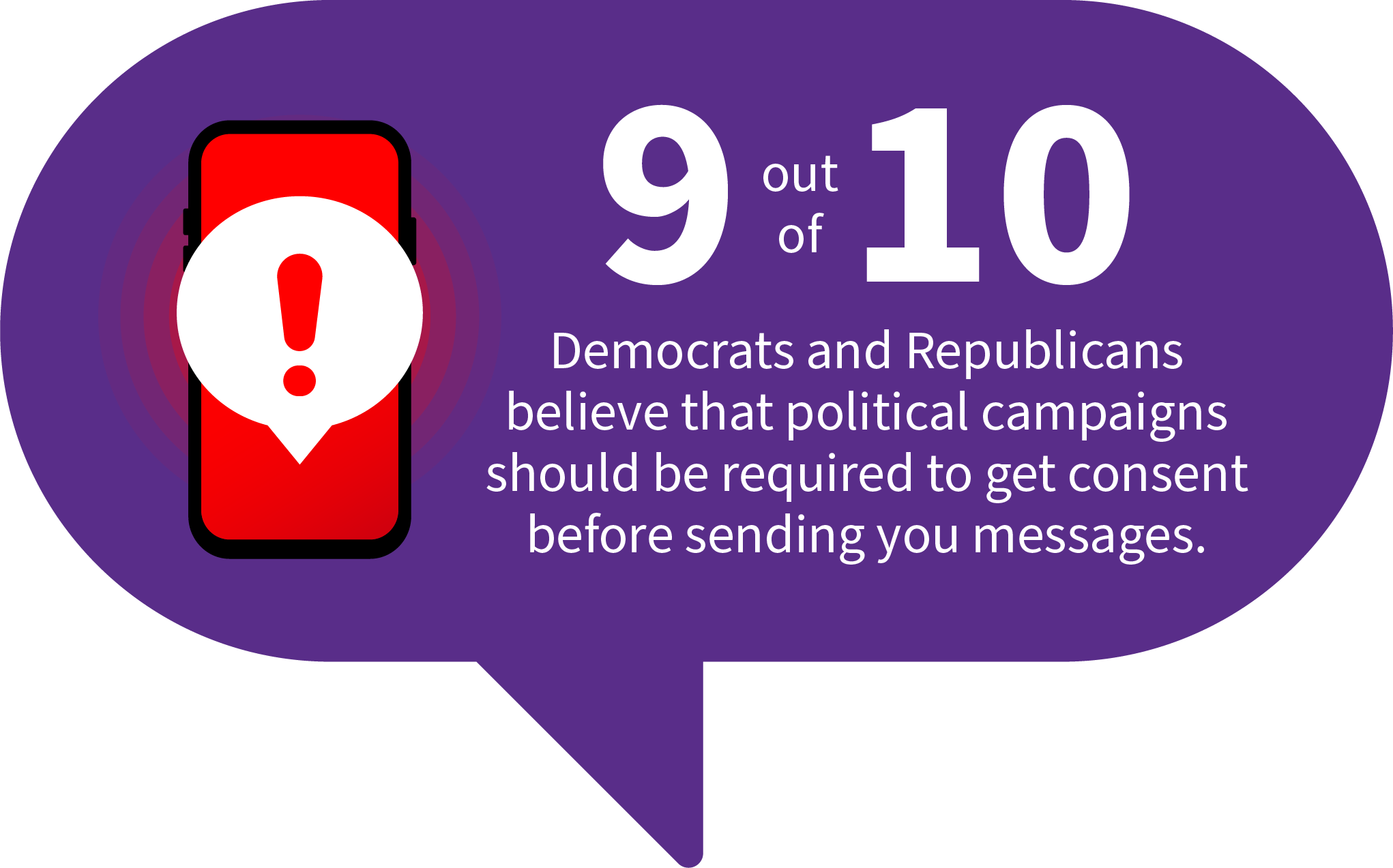Consent is key to engaging positively with consumers—including potential voters.
Wireless text messaging is a powerful and effective way to organize, inform, and engage voters, which is why billions of texts are sent in election cycles from political campaigns of both parties.
But it is important that campaigns use text messages to reach voters in a responsible manner.
To engage most productively with consumers, all message senders should get meaningful, opt-in consent prior to sending messages.
Americans rightfully expect that they will not receive unwanted texts. That starts with the consumer belief that all organizations should obtain consent before sending any type of text message—including texts from political campaigns, causes, and candidates.
More than 4 out of 5 consumers express frustration with receiving unsolicited political messages, and that feeling is growing even stronger with each election cycle—up 20% from 2020. A recent survey also confirmed what consumers say every day—spam is spam, whether it’s an unwanted text from a bank, a concert promoter, or a campaign.
In general, message senders, including political campaigns, should:
- Obtain a consumer’s opt-in consent to receive text messages.
- Ensure that consumers can opt-out from receiving all future messages from a particular message sender—and that these requests are honored.
- Take steps described in the CTIA Messaging Principles & Best Practices to send text messages consumers want and refrain from sending texts they do not want.


Frequently Asked Questions
How to successfully engage with consumers via text message—and how consumers can protect themselves from unwanted texts.
-
01
Why is texting a great tool for reaching consumers?
Text messaging campaigns are so effective because consumers open and read their texts. This isn’t by accident. The stakeholders in the wireless messaging ecosystem work hard every day to maintain consumer trust in text messaging and limit spam in the wireless text messaging environment.
-
02
What are best practices for communicating with voters?
Campaigns should get clear consumer consent to send text messages, as CTIA’s Messaging Principles and Best Practices suggests. In addition to communicating only with consumers who have opted-in, senders should:
- Clearly identify themselves
- Tell consumers how to opt-out, by replying “STOP,” for example
- Honor those opt-out requests
- Establish clear privacy and security policies and practices
These best practices are designed to apply the same standards and same consumer protections regardless of whether the sender or the consumer is an airline or a bank, a hospital or a college, or a campaign.
-
03
How do you obtain consumers' consent to send them text messages?
There are many ways for political message senders to solicit and obtain a voter’s consent to receive text messages. For example, as described in CTIA’s Messaging Principles and Best Practices, one of the best ways to seek consent is to invite a consumer to check a box next to language that says “I agree to receive text messages from this campaign” alongside a clear and conspicuous description of the campaign and the types of messages the consumer can expect to receive if they opt-in. This can be provided online, on a form, or through other mechanisms that enable message senders to document consumers’ consent as described in the Messaging Principles.
Some other examples of reasonable consent mechanisms, when accompanied by appropriate consumer disclosures, include, but are not limited to:
- Entering a telephone number through a website
- Clicking a button on a mobile webpage
- Sending a message from the consumer’s mobile device that contains a keyword
- Initiating the text message exchange in which the message replies to the consumer only with responsive information
- Signing up at a point-of-sale or other message sender on-site location
- Opting-in over the phone using interactive voice response technology
When collecting consent, message senders should display clear and conspicuous disclosures (“calls to action”) about the type and purpose of the messaging the consumer will receive. As described in CTIA’s Messaging Principles and Best Practices, message senders should obtain proper consumer consent for each messaging campaign supported.
By giving consent to one message sender, a consumer does not expect their telephone number to be used by another message sender through sale, lease, transfer, or other sharing of recipient lists.
Consumers have legitimate expectations about what does and does not constitute consent to receive political texts. For example, two-thirds of consumers agreed:
- Voting for a certain candidate does not mean that they consent to receive texts from that candidate
- Donating to a certain candidate does not mean that they consent to receive texts from that candidate
- Consenting to texts from one candidate does not mean that they consent to receive texts from another candidate
-
04
I’m a consumer. What do I do if I’m receiving messages I don’t want?
If you provide your phone number to a potential message sender, make sure you know what type of communication you are opting into. If you receive a text that seems legitimate, but you do not want, you can simply respond “STOP” to opt-out of getting any more texts. If you receive an unexpected or suspicious text, do not click any links. If you receive a text that looks suspicious, you should forward the message to 7726 (SPAM)—here are instructions for iPhone and Android.
Here are some additional tips to help you keep control over your texts:
- Click “Delete and Report Junk” and Report spam messages to Apple for iPhone users and Google for Android users. Click the links to learn how.
- Depending on your device, you may also be able to block the sender. Check with your cellphone manufacturer (Apple, Samsung) to learn more.
- You can also report spam messages by filing a complaint with the FTC or FCC.
- Do not click on text or email links in unwanted texts from sources you don’t know.
- To learn more about how to protect yourself from spam texts, watch our How to Stop Spam Text Messages video and visit the Consumer Resources tab.